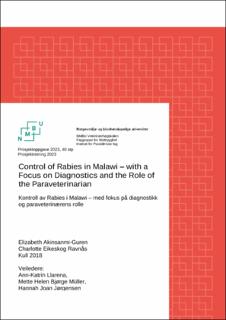| dc.contributor.advisor | Llarena, Ann-Katrin | |
| dc.contributor.advisor | Bjørge Müller, Mette Helen | |
| dc.contributor.advisor | Jørgensen, Hannah Joan | |
| dc.contributor.author | Ravnås, Charlotte Eikeskog | |
| dc.contributor.author | Akinsanmi, Elizabeth Opeyemi | |
| dc.coverage.spatial | Malawi | en_US |
| dc.date.accessioned | 2023-12-11T11:19:06Z | |
| dc.date.available | 2023-12-11T11:19:06Z | |
| dc.date.issued | 2023 | |
| dc.identifier.uri | https://hdl.handle.net/11250/3106824 | |
| dc.description.abstract | Rabies is a neglected viral disease that kills 59,000 people worldwide each year. Most of these deaths occur in Africa and Asia and are almost always due to dog bites. Rabies is vaccine preventable and mass dog-vaccination can effectively block the transmission of rabies to humans. Malawi is a South-Eastern African country where rabies is endemic. Due to inadequate testing of suspected rabid animals and poor surveillance systems, the true burden of rabies is unknown in Malawi. In this study, barriers to rabies control and sampling were explored. Different transport media for submission of samples to laboratories were assessed, as well as the suitability of RT-qPCR and LFT testing methods in Malawi’s Central Veterinary Laboratory. The current situation in rabies control and surveillance was evaluated through individual interviews and focus group discussions with Malawian Assistant Veterinary Officers. The elimination of rabies in Malawi is hindered by poor resource allocation to awareness campaigns, dog vaccination, rabies diagnostics and inefficient rabies surveillance systems. A ‘One Health’ approach is required with true collaboration between animal and human healthcare sectors, with more resource allocation to rabies control, so that Malawi can progress towards eradicating dog-mediated rabies cases in humans. | en_US |
| dc.description.abstract | Rabies er en neglisjert zoonose som årlig dreper 59 000 mennesker. De fleste dødsfallene rammer i Afrika og Asia, og de aller fleste tilfellene skyldes hundebitt. Rabies kan forhindres med vaksinasjon. Vaksinasjon av hundepopulasjonen vil effektivt forhindre rabiessmitte til mennesker. Malawi er et land i sør-østlige Afrika, med endemisk forekomst av rabies. Mangelfull testing og dårlig overvåkning gjør det vanskelig å vurdere omfanget av sykdommen i Malawi. I denne studien undersøkes barrierer for kontroll og prøvetakning av rabies i Malawi. Ulike transportmedier for prøvemateriale til laboratorieanalyser ble vurdert. Det ble også gjort en sammenlikning av de diagnostiske metodene RT-qPCR og LFT ved CVL. Fokusgruppe-diskusjoner og individuelle intervjuer med malawiske paraveterinærer ble gjort for å undersøke hva som gjøres for å kontrollere og overvåke rabies i felt. Rabiesbekjempelse i Malawi hindres av ressursmangel i alle ledd, fra holdningskampanjer til vaksinering, diagnostikk og overvåkning. Et «Én Helse»-perspektiv med tverrfaglig samarbeid mellom sektorer for folkehelse og -dyrehelse, i kombinasjon med økt bevilgning av økonomiske midler til kontrolltiltak er essensielt for fremgang i bekjempelse av hundemediert rabies hos mennesker i Malawi. | en_US |
| dc.language.iso | eng | en_US |
| dc.publisher | Norwegian University of Life Sciences, Ås | en_US |
| dc.rights | Attribution-NonCommercial-NoDerivatives 4.0 Internasjonal | * |
| dc.rights.uri | http://creativecommons.org/licenses/by-nc-nd/4.0/deed.no | * |
| dc.title | Control of Rabies in Malawi : with a focus on diagnostics and the role of the paraveterinarian | en_US |
| dc.title.alternative | Kontroll av Rabies i Malawi : med fokus på diagnostikk og paraverinærens rolle | en_US |
| dc.type | Student paper, others | en_US |
| dc.relation.project | Norges forskningsråd: 326267 | en_US |
| dc.relation.project | Norwegian Agency for International Cooperation and Quality Enhancement in Higher Education: NORPART-2021/10332 | en_US |
| dc.description.localcode | VET | en_US |

